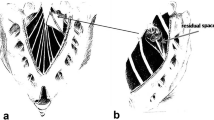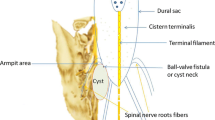Abstract
Background
Symptomatic midline sacral meningeal cysts (MSMC) are rare, and, as a consequence, so are reports on the surgical techniques to address these lesions. Here we provide a description of the senior author’s (ATC) technique.
Method
A sacral laminectomy is performed. The cyst’s relation with the dural sac and sacral nerves is inspected; it is then opened and drained. Its lumen is explored for its point of communication with the dural sac, and this ostium is closed off with non-penetrating clips. A lumbar drain is inserted in select cases.
Conclusion
Cyst wall resection is unnecessary and closing the ostium is sufficient to treat MSMC.




Similar content being viewed by others
Data availability
Not applicable.
Abbreviations
- CSF:
-
Cerebrospinal fluid
- LD:
-
Lumbar drain
- MSMC:
-
Midline sacral meningeal cyst
- MRI:
-
Magnetic resonance imaging
References
Cheng JS, Song JK (2003) Anatomy of the sacrum. Neurosurg Focus 15:E3. https://doi.org/10.3171/foc.2003.15.2.3
Feigenbaum F, Henderson F (2006) Surgical management of meningeal cysts, including perineural (Tarlov) cysts and meningeal diverticula. Semin Spine Surg 18:154–160. https://doi.org/10.1053/j.semss.2006.06.004
Feigenbaum F, Henderson FC (2006) Giant sacral meningeal diverticula: surgical implications of the “thecal tip” sign. Report of two cases. J Neurosurg Spine 5:443–446. https://doi.org/10.3171/spi.2006.5.5.443
Fogel GR, Cunningham PY 3rd, Esses SI (2004) Surgical evaluation and management of symptomatic lumbosacral meningeal cysts. Am J Orthop (Belle Mead NJ) 33:278–282
Nabors MW, Pait TG, Byrd EB, Karim NO, Davis DO, Kobrine AI, Rizzoli HV (1988) Updated assessment and current classification of spinal meningeal cysts. J Neurosurg 68:366–377. https://doi.org/10.3171/jns.1988.68.3.0366
Nastoulis E, Karakasi MV, Pavlidis P, Thomaidis V, Fiska A (2019) Anatomy and clinical significance of sacral variations: a systematic review. Folia Morphol (Warsz) 78:651–667. https://doi.org/10.5603/FM.a2019.0040
Sakka L, Gabrillargues J, Coll G (2016) Anatomy of the spinal meninges. Oper Neurosurg (Hagerstown) 12:168–188. https://doi.org/10.1227/NEU.0000000000001048
Tarlov IM (1970) Spinal perineurial and meningeal cysts. J Neurol Neurosurg Psychiatry 33:833–843. https://doi.org/10.1136/jnnp.33.6.833
Author information
Authors and Affiliations
Contributions
All authors contributed to the manuscript’s conception and design. The first draft was written by Ivan Cabrilo and critically revised by all three authors. All authors read and approved the final manuscript.
Corresponding author
Ethics declarations
Competing interests
The authors declare no competing interests.
Additional information
Key points
▪ Although rare, the intracystic buildup of CSF within MSMC can cause symptomatic compression of the sacral nerve roots.
▪ MSMC are meningeal diverticula, connected to the tip of the dural sac through a pedicle that is thought to function as a ball-and-valve mechanism [5].
▪ Simple drainage is therefore usually associated with recurrence [2] and closure of the ostium is required.
▪ Closure of the ostium is usually sufficient to treat MSMC, and aggressive resection of the cyst’s walls is not necessary.
▪ The incision and approach are therefore limited to exposing the portion of the cyst where the ostium is located.
▪ Careful muscle stripping and drilling, to avoid inadvertently breaking into thinned down or absent dorsal sacral bone.
▪ The ostium may not be apparent.
▪ Valsalva manoeuvres may help to locate the ostium.
▪ Complex septations may need to be taken down before the ostium can be closed off.
▪ Non-penetrating clips are used for closure, to avoid suturing needle puncture holes.
Publisher's note
Springer Nature remains neutral with regard to jurisdictional claims in published maps and institutional affiliations.
This article is part of the Topical Collection on Spine—Other
Supplementary Information
Below is the link to the electronic supplementary material.
Video. Surgical video, through operating microscope, of patient from Figures 1, 3-4. Patient history: 18-year-old female, previously fit and well, presented with pain in the lower back and lower abdomen associated with a progressive disturbance of bladder sensation and voiding, and ultimately with urinary retention that had initially been attributed to Fowler’s syndrome. Multiple trials without urinary catheter had failed. Shooting groin pain and gluteal region paraesthesia were also reported. Further radiological work-up revealed a large midline sacral meningeal cyst that was drained percutaneously under CT guidance. A near-immediate improvement of symptoms was reported and the patient was once more able to pass urine normally and was no longer catheter-dependent. 10 days later, her symptoms progressively re-appeared, and she was again found to be in urinary retention. An MRI demonstrated that the cyst had recollected, at which point she was referred to our hospital for consideration of surgical management, to which she and her family consented. Video commentary: The L5/S1 window and dorsal sacrum are exposed through a midline incision. The incision and laminectomy are limited to exposing the portion of the cyst where the ostium is located. Flowable haemostatic matrix (Surgiflo®; EthiconTM, Somerville, NJ, USA) is useful to control epidural venous bleeding (00:11 – 00:31). An intraoperative fluoroscopy (00:31 – 00:40) aids to orientate to the level of the cyst’s ostium (S2/S3 junction, see Figures 1 & 3). The absence of dorsally running nerve roots is confirmed (00:41 – 00:46). (00:46 – 01:23) The cyst is entered through a tear in its dome and its lumen is explored for the pedicle that connects it to the dural sac, without a clear communication found. A Valsalva manoeuvre causes CSF to pearl at the base of the intracystic septum, where the wall also appears thinner and where vessels are seen entering into the cyst (01:15, asterisk): these all represent give-away signs to the ostium’s location. (01:24 – 01:47) Blunt dissection of this region reveals a small spherical cyst with an arachnoid lining, effectively communicating with the lumbosacral CSF cistern (see Figure 3). (01:47 – 01:49) This cyst is incised and its arachnoid septa taken down with a blunt hook (01:50 – 01:56) so as to incorporate the arachnoid sheets into the ostial repair along with the dural layer, and so avoid an only partial closure of the ostium (01:57 – 02:06). For this, we use non-penetrating clips (AnastoClip®; LeMaitre Vascular, Inc., Burlington, MA, USA). (02:06 – 02:20) Closure is reinforced with alternating layers of fibrin sealant (shown here, Evicel®; EthiconTM, Somerville, NJ, USA) and collagen-based dural regeneration matrix (shown here, DuraGen®; Integra®, Plainsboro, NJ, USA; and DuraGen®; Integra®, Plainsboro, NJ, USA / DurepairTM; Medtronic, Minneapolis, MN, USA). A lumbar drain is inserted intraoperatively, followed by a watertight closure of the musculofascial and skin layers. Patient outcome: Sustained postoperative symptom resolution, including retrieved ability to control and pass urine. (MP4 342815 KB)
Rights and permissions
About this article
Cite this article
Cabrilo, I., Zaidman, N. & Casey, A.T. Midline sacral meningeal cyst decompression and repair. Acta Neurochir 163, 2777–2781 (2021). https://doi.org/10.1007/s00701-021-04948-3
Received:
Accepted:
Published:
Issue Date:
DOI: https://doi.org/10.1007/s00701-021-04948-3




